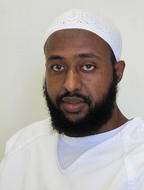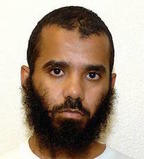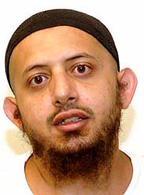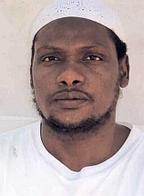Five More Prisoners Approved for Release from Guantánamo: 18 of the 39 Remaining Men Are Now Waiting to Be Freed

One of the extraordinary sculptures of ships made from recycled materials at Guantánamo by Yemeni prisoner Moath al-Alwi, who has just been approved for release, after being held for over 20 years without charge or trial.
If you can, please make a donation to support our work in 2022. If you can become a monthly sustainer, that will be particularly appreciated. Tick the box marked, "Make this a monthly donation," and insert the amount you wish to donate.
By Andy Worthington, January 18, 2022
In the run-up to the shameful 20th anniversary of the opening of the prison at Guantánamo Bay on January 11, I had the sneaking suspicion that President Biden would seek to divert attention from his general inaction on Guantánamo in his first year in office by announcing that more of the facility’s "forever prisoners" had been approved for release.
In his first year in office, President Biden released just one prisoner, even though he inherited six men approved for release from the previous administrations, but crucially, via the Periodic Review Boards, the review process established by President Obama, he has also now approved an additional 13 men for release — one-third of the remaining 39 prisoners — bringing to 18 the total number of men still held who the U.S. government has conceded that it no longer wants to hold.
This is definitely progress — although it means nothing until the men in question are actually released — but it does show a willingness to move towards the prison’s closure, and also indicates that the administration has taken on board the criticism of numerous former officials, and, in particular, 24 Senators and 75 members of the House of Representatives, who wrote to President Biden last year to point out how unacceptable it is that the government continues to hold men indefinitely without charge or trial.
As all the critics explained, after 20 years, it is imperative that the men held are either charged or released. Finally, there has been a widespread acceptance — except from fanatical pro-Guantánamo Republicans — that there is a fundamental problem in trying to construct an argument that endorses holding men for the rest of their lives without ever even attempting to charge them with a crime.
Suhayl al-Sharabi

Suhayl al-Sharabi, in a photo included in his classified military file released by WikiLeaks in 2011.
Of the five men approved for release, who are all in their 40s, two were approved for release on November 10, although those recommendations have only just been made public. The first, Suhayl al-Sharabi (ISN 569), a Yemeni, was seized in a house raid in Karachi, Pakistan on February 7, 2002, with 16 other men, who all ended up at Guantánamo, and have all, with one exception, been released. The exception is Sharqawi al-Hajj (ISN 1457), held and tortured in CIA "black sites" before his arrival at Guantánamo in September 2004, and while he was regarded as an al-Qaeda facilitator, he was approved for release by a PRB in June last year.
The allegations against al-Sharabi in his PRB in June (the first he took part in since his ongoing imprisonment was approved in 2016) suggested that he "trained in Afghanistan before 9/11," that he "became a bodyguard for Usama bin Ladin" [sic] and also that he "may have been associated with an aborted 9/11-style hijacking plot in Southwest Asia that was led by al-Qa’ida external operations chief Khalid Shaykh Muhammad."
It has, it should be noted, never been clearly established that he was a bodyguard for bin Laden, and the allegation about his involvement with a plot in Malaysia, which was previously brandished by the U.S. authorities as some kind of damning fact, has clearly unraveled over the years, as it was only suggested that he "may have" taken part in it.
More significantly, what mattered in the PRB was that al-Sharabi expressed regret, and a desire for a peaceful life if released, and, although his own statement hasn’t been made publicly available, his Personal Representative (a military official chosen to represent him) explained to the board members that he "has expressed regret for what happened in the past and desires to be re-united with his family to lead a peaceful life, free of trouble," adding, "Based on our interactions, I have not seen any indications that he is a continuing threat to the United States or its allies."
The Personal Representative also noted that al-Sharabi understood that, if he were to be released, "the current situation would not be conducive to his return to Yemen," and indicated that he "would like to go to Oman or [a] similar Arabic country," where he would be "willing to support himself in whatever field becomes available."
Guled Hassan Duran

Guled Hassan Duran, in a photo taken at Guantánamo.
The second man approved for release on November 10 was Guled Hassan Duran, identified by the U.S. authorities as Guleed Hasan Ahmed (ISN 10023), a Somali, and one of the 14 "high-value detainees" who arrived at Guantánamo from CIA "black sites" in September 2006. His approval for release perhaps augurs well for the other "high-value detainees" who arrived at Guantánamo with him and who are still held without charge or trial, unlike the ten who have been charged (and one other who was sent to the U.S. for trial). The others are Abu Zubaydah, the first victim of the CIA torture program, (ISN 10016) and Abu Faraj al-Libi (ISN 10017), about whom very little has been heard.
Duran’s arrival at Guantánamo was always inexplicable, as he had nothing to do with al-Qaeda and 9/11 (when he met Khalid Sheikh Mohammed in the "black sites," apparently, KSM had no idea who he was). The U.S. authorities, however, alleged that he was involved with al-Qaeda in East Africa. As his lawyers at the Center for Constitutional Rights explained, he "was seriously injured in a gun fight with gang members who were trying to steal his motorcycle in Mogadishu in December 2003, and was captured on March 4, 2004 when he was transiting through Djibouti on his way to Sudan for surgery." As CCR also explained, "Throughout his CIA detention, interrogators withheld medical care to pressure him to cooperate, including to recruit him as a spy, and to agree to provide more information," and he "was flown to several locations before arriving at Guantánamo in September 2006." Crucially, he told his lawyers that "the FBI interrogated him shortly after he arrived, but he refused to answer any questions," and "has not been interrogated by anyone since."
Duran’s review — the first he took part in since 2016, when his ongoing imprisonment was approved — included a detailed submission from his lawyers, and, as they described it on their website, letters of support from relatives, as part of his "large and close-knit family and support network." As they also explained, "He is one of seven children, and his brother and sisters speak fondly of their childhood together in Somalia and describe him as a family man who loves his wife and four children deeply and who suffers from being separated from them for so long."
In a statement submitted for his PRB in July, Duran stated, "I do not have any ill-will toward the United States. I never have." He also apologized for sometimes being non-compliant during his long imprisonment without charge or trial, but urged the board members to consider how "[i]t is very frustrating and demoralizing being held for so long when you have no idea when you will be released, and sometimes it boils over."
He insisted, however, that "All I want is just to move on with my life. I want to be reunited with my wife and children. I have lost so much time with them, and it has been very difficult for everyone." He added, "I am willing to be transferred anywhere, under any circumstances, where I can live a quiet life and eventually be reunited with my family. I want to get a job and support them the way I have not been able to for a very long time. I hope your decision will allow me to have a future beyond Guantánamo."
Moath al-Alwi

Moath al-Alwi, in a photo included in his classified military file released by WikiLeaks in 2011.
The other three men were approved for release on December 27, and it’s a sign of the general invisibility of Guantánamo’s prisoners that only one of the five men approved for release who anyone may have heard of — outside of the small pool of dedicated Guantánamo-watchers — is Moath al-Alwi (aka Moaz al-Alawi), a Yemeni who sprang to prominence in "Ode to the Sea: Art from Guantánamo," an exhibition at the John Jay College of Criminal Justice in New York in 2017-18.
Al-Alwi, most noticeably, made astonishing models of sailing ships entirely out of scavenged, recycled materials, "including cardboard, old t-shirts, and parts of the plastic housing of shaving razors," as his exhibition page explains, and this summer the largest of his ships, the aptly-named "Giant," was featured in a video made for the New York Times. He also made furniture, and painted relief sculptures, and I posted some of his work in my article about a follow-up to the John Jay College exhibition at CUNY School of Law’s Sorensen Center for International Peace and Justice, in Long Island City, in January 2020. For more on al-Alwi’s talents at Guantánamo, see Chapter 22 of former prisoner Mansoor Adayfi’s compelling memoir, "Don’t Forget Us Here: Lost and Found at Guantánamo," published last summer by Hachette Books, which records a brief period when prisoner art was allowed to flourish in the prison.
As for why he is still languishing in Guantánamo, over 20 years since his arrival at the prison, on January 17, 2002 — and why he has only just been approved for release — no compelling reason is apparent. He was once regarded as a bodyguard for Osama bin Laden, but as the U.S. government conceded in its profile of him for his PRB in October, although he was regarded as "an al-Qa’ida-affiliated fighter who spent time with Usama bin Ladin’s security detail," he "probably was not one of his bodyguards." The authorities also noted that, although he allegedly "developed relationships with many prominent extremists in Afghanistan and spent time with al-Qa’ida and Taliban fighters on the frontlines," we "do not know whether he engaged directly in combat."
Without any certainty regarding these allegations, then, it seems reasonable to assume that the authorities’ position regarding al-Alwi’s ongoing imprisonment— until last month — was based on a perception of his attitude since he has been held at Guantánamo, rather than on connections with al-Qaeda or the Taliban that are the supposed rationale for imprisonment at Guantánamo.
For many years, al-Alwi was a persistent hunger striker, weighing just 97 pounds at the time of his first PRB in September 2015, when, despite recognizing that he was, nevertheless, regarded as "compliant," the board members judged him to have been "evasive and hostile in response to its questions as well as failing to acknowledge or accept responsibility for his prior actions."
At a second review, in November 2016, his attorneys, Beth Jacob and Ramzi Kassem, pointed out to the board that he had given up his hunger strike, and also pointed out the widespread appreciation of his talents as an artist, but the board members nevertheless asserted that they were "unable to determine" whether he had "had a change in his extremist mindset due to his terse and vague responses to questions from Board members," and also damned him for his "significant noncompliance" prior to July 2015. Another review took place in March 2018, when Donald Trump was in office, and, shamefully, the board members didn’t reach a decision for two years and seven months, and, when they did, it was only to approve his ongoing imprisonment in a terse five-line decision that provided no details whatsoever about their rationale.
Clearly, al-Alwi should have been approved for release many years ago, and it is to be hoped that a new home can be found for him as swiftly as possible, given the prohibition against repatriating any Yemeni prisoners. As his Personal Representative explained at his hearing in October, "Moath is passionate about art and hopes to continue his education and training to make this passion a career. His artwork has been showcased in numerous exhibits and evaluated by art critics and instructors who feel that Moath has a real talent and could make a living using this talent."
As the Personal Representative also explained, "In addition to art projects, Moath spends his time cooking, attending class, and improving his English language skills. He is consistently listed amongst the most compliant currently in detention [and] has committed to attend any rehabilitation program that the Board directs. With the help and support from his family and his legal staff, I feel that Moath has a good support team which should ease his transfer and transition."
Omar al-Rammah

Omar al-Rammah, in a photo included in his classified military file released by WikiLeaks in 2011.
The second prisoner approved for release on December 27 — an approval that was also long overdue — is Omar al-Rammah (ISN 1017), another Yemeni, whose real name is Zakaria, and who, it seems abundantly clear, should never have been brought to Guantánamo in the first place.
Al-Rammah, as I explained in my book The Guantánamo Files, published in 2007, was captured far from the battlefields of Afghanistan — in Georgia, formerly part of the Soviet Union, in April 2002, with an Algerian, Soufian al-Hawari (ISN 1016), who was freed in November 2008. After spending over a year in CIA “black sites,” al-Rammah arrived at Guantánamo in May 2003.
As al-Hawari explained in Guantánamo, "The Americans didn’t capture me. The [Russian] Mafia captured me. They sold me to the Americans … When I was captured, a car came around and people inside were talking Russian and Georgian … We were delivered to another group who spoke perfect Russian. They sold us to the dogs. The Americans came two days later with a briefcase full of money. They took us to a forest, then a private plane to Kabul."
When asked who was with him, al-Hawari replied, "There were four of us. Myself, my friend Abdul Haq, a Yemeni guy named Zakaria [al-Rammah], and a Chech[en] driver, who was killed." According to a Cageprisoners report, based on accounts provided by former prisoners, they were sold to the Americans for $100,000.
Al-Rammah has not spoken at Guantánamo in any publicly released records, but, according to reports from released prisoners, he was subjected to brutal treatment in the early days of the prison’s existence, even though the U.S. authorities had no reason to suppose that he was anything more than a low-level facilitator working with Muslim freedom fighters in Chechnya.
His case was reviewed in July 2016, when Beth Jacob, who had recently become his attorney, explained, in what struck me as a heartbreaking account, that he had "not been able to make contact with his family since his arrival at Guantánamo," and that his "last conversation with his mother was in 2002 from Georgia, when she told him to come home." Despite all of the above, the board members approved his ongoing imprisonment a month later.
He had another review in February 2017, at which his Personal Representative noted that he was now in touch with his family, who are "highly educated and well traveled," and who had "offered both the emotional and monetary support necessary for Zakaria’s transition." The personal representative added that, "Since learning that Zakaria was still alive, they have had several family meetings and developed a thorough plan to include having a family member by Zakaria’s side, regardless of where he is transferred to. The initial plan is to have Zakaria’s mother by his side while other family members rotate bimonthly." He was also described as "one of the better behaved detainees," who "has had very few behavioral problems during his detention," and "is described as calm and quiet by camp staff."
Shamefully, as with Moath al-Alwi, the board members failed to deliver a swift verdict in al-Rammah’s case. Three years and eight months after his hearing, in October 2020, his ongoing imprisonment was upheld, and he then had to wait another year for the follow-up hearing that has finally approved him for release. As the board members stated, in making their determination they had "considered [his] low level of involvement with extremists prior to detention," and the complete absence of "information indicating that [he] engaged in activities against the United States," and also recognized the support of his family and his attorney. Refreshingly, they also recognized that, although there has been "an increase in incidents of non-compliance over the last couple of years," the evidence suggested that this was "a result of stress," and, sadly, "his deteriorating mental health." I can only hope that a new home will be found for him as soon as possible.
Mohammed Abdul Malik Bajabu

Mohammed Abdul Malik Bajabu, in a photo taken at Guantánamo.
The last of the three men approved for release on December 27 is another man whose rendition to Guantánamo in the first place — like Guled Hassan Duran and Omar al-Rammah — made no sense. Mohammed Abdul Malik Bajabu (ISN 10025) is a Kenyan, and a father of three, who was one of the last prisoners to arrive at Guantánamo, in March 2007. Although the Pentagon claimed at the time that he was a "dangerous terror suspect," who had admitted to involvement in terrorist attacks, he is one of the few prisoners at Guantánamo who were not given a Combatant Status Review Tribunal, which is a pre-requisite to be put forward for a trial by military commission, suggesting that there was actually no case against him.
What actually happened, it seems clear from investigations by his lawyers at Reprieve, is that he was seized and badly beaten by Kenyan police, who, although they "apparently found no evidence linking [him] to any criminal activity … drove him to an airport and handed him, with no form of judicial process, to U.S. military personnel." From Kenya, as Reprieve explained, he was flown to Djibouti, "where he was detained in a shipping container on a U.S. military base and told by interrogators that he was about to embark on a 'long, long journey,'" and was then flown to Afghanistan, where he was held at Bagram "in appalling conditions," and at a second prison, and was then flown to Guantánamo.
Reprieve made presentations on his behalf at his PRB in May 2016, but his ongoing imprisonment was approved a month later, with the board members convinced that he had "a close relationship with high-level operational planners and members of al-Qa’ida in East Africa," and that he had been involved in "the November 2002 attacks in Mombasa, Kenya," although they acknowledged that he had been "a highly compliant detainee," who had "not expressed continued support for extremist activity or anti-US sentiments," although he was "critical of U.S. foreign policy."
In July 2019, Bajabu, like the majority of prisoners under Donald Trump, boycotted his next hearing, having rightly concluded that the process had become a toothless sham, and it took until September 2021 for him to have another chance to persuade the board that there was no reason to hold him, at which he was finally successful.
His attorney, Mark Maher of Reprieve, certainly painted a compelling picture of his client as a man who should be freed. He pointed out that he is "among the most compliant detainees, a result of his devotion to peace and healing." As he proceeded to explain, "Prior counsel has noted that he can quote from Mohandas Gandhi and Dr. Martin Luther King like teenagers quote Taylor Swift," and he also noted that "[h]e practices meditation and yoga, and identified himself as a 'healer' — something he was doing long before his detention."
As he also explained, "He is constantly reassuring others that everything will be alright. I have spoken to family members of his who have lost jobs, received troubling medical news, and experienced the loss of loved ones who have been buoyed by their family calls with Abdul Malik," who is "patient, tolerant and empathetic," and who, "While he has never downplayed the effects of his long incarceration … has always approached his situation positively, dispelling any negativity with humour and grace."
The board members, subsequently making their determination to approve his release, did not reflect on his evidently positive attributes as a human being, but did note his "low level of training and lack of leadership role in his pre-detention activities," his "compliance in detention," and "the support available to him from family members and multiple NGOs if transferred," and they also made a point of noting "the dissipation of the network of extremist associates with which he was previously involved."
* * * * *
In conclusion, then, it is reassuring to hear about these five men being approved for release, but, as I stated at the start of the article, it will mean nothing if they are not actually freed. I must also note that it does nothing to address the insubstantial legal basis for imprisonment at Guantánamo, which the Biden administration seems to have no interest in addressing, as the Justice Department continues to defend the imprisonment of anyone unfortunate enough to try to secure their release through a court, leaving the non-binding administrative deliberations of the PRBs as the driver of Biden’s Guantánamo policy.
The five decisions above must also be set against another decision taken on December 27 — to approve the ongoing imprisonment of Khaled Qassim, another low-level foot soldier whose continued detention was justified by the board because of the perception that he has a bad attitude — but for now I won’t discuss his case any further, as it will be subject of a separate article to follow soon.
In parting, however, feel free to check out the live video of my song about Khaled, "Forever Prisoner," recorded with my band The Four Fathers, which we released on the 20th anniversary of the prison’s opening.




